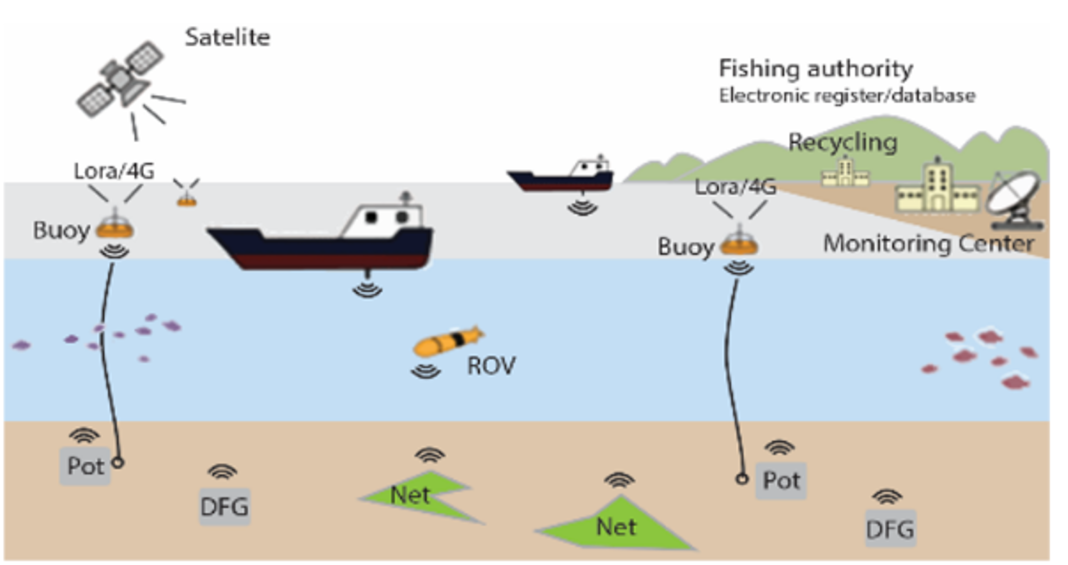Marine plastic pollution is a global crisis with increasing impacts on the environment, marine life, and human health. Multinational and national organisations are working to develop solutions that are accepted by all stakeholders connected to the marine environment and fishing industry
Marine plastic litter is harming marine ecosystems through ingestion, entanglement, and the possible release of toxic chemicals. A study from the North Sea showed that 93% of fulmar birds analysed had ingested plastic, with approximately 60% exceeding the 0.1 g level of plastic ingestion.
Similarly, in the Mediterranean Sea, 85% of assessed turtles were found to have ingested litter. Although most of the marine plastic litter in the oceans originates from land-based sources such as bottles, food containers and synthetic clothing, a significant portion estimated at 27% comes from fishing-related activities on European beaches. (1,2)
In the Baltic Sea alone, an estimated 450 tonnes of lost gillnets continue to catch ca. 300 tonnes of cod annually, a phenomenon known as ‘Ghost fishing’, up to 10,000 gillnets are lost per year. This plastic litter has wide-reaching impacts, from environmental degradation to economic losses, disrupting fishing and navigation, and posing risks to human health and safety.
Solutions for the marine environment and fishing industry
Fortunately, this multi-faceted global problem is beginning to receive the serious attention it deserves. The activities of multinational, national and private organisations – such as the European Union, United Nations, Global Ghost Gear Initiative (GGGI), and G20 Marine Plastic Litter Framework – are intensifying as they work to find solutions accepted by all stakeholders connected to the marine environment and fishing industry.
Lost or discarded fishing gear presents a complex challenge due to the difficulty of locating objects in the underwater environment, which is compounded by technological, economic, and awareness barriers. International guidelines recommend that fishing gear (FG) be marked in accordance with national legislation to facilitate owner identification. However, these guidelines primarily focus on surface-level navigation safety such as metal tag on buoys, without requiring marking the submerged gear itself.
In the future, an international standard for underwater FG marking labelling will likely be established, allowing for easier localisation, traceability, retrieval, recycling and certification. Benefitting both professional and recreational fishermen as well as marine organisations (Figure 1). Such a labelling system would also assist governing authorities in their efforts work to enhance circular economy practices for marine resource management (Figure 2) and support fishing gear manufacturers in meeting future requirements for increased producer responsibility.

Marine plastic litter: Challenges and technological and legislative progress
As marine plastic litter is recognised to have a profound global impact on the environment, with severe consequences anticipated for the future. There are significant research and innovation efforts aimed at developing viable solutions for reporting, marine litter cleaning, marking and raising awareness about marine litter. These efforts are supported by various funding opportunities such as European Horizon, the GGGI, and numerous national initiatives.
One notable example is the Swedish project ‘Find Me’, which is developing solutions for the underwater location of fishing gear as the first step in retrieval and recycling. The project includes partners from enterprises, industry, agencies, research institutes, and professional fishermen, all working together to mitigate the damages caused by DFG losses. The project faces many challenges – technological, regulatory, and economic.
The primary technological challenge in underwater localisation, traditionally done by sonar and divers, is that most fishing gear is located on rocky sea floors, making it extremely difficult to distinguish. The absence of affordable and easy-to-use technology for FG underwater localisation, coupled with an unclear market, makes it challenging to motivate companies to invest in development. Organisations are often hesitant to invest in new, innovative solutions even when clear benefits can be demonstrated, preferring to invest in established and robust solutions.
Fortunately, technologies from various research areas are advancing rapidly, and awareness of the plastic litter crisis is growing. As these trends converge, solutions will emerge and be refined for these highly challenging underwater environments. The Swedish Agency for Marine and Water Management, project partner, emphasises that “the work with marine litter, lost fishing gear include both extra operational collection and trawling efforts but also preventive efforts such as training of fishermen, guidance regarding trawling, information for recreational fishermen and also collection of information regarding the location of lost fishing gear”.
During our field tests and when project partners Havstens Fiskelag AB and Väderö Fisk AB are out at sea, they consistently find alarming amounts of fishing gear that have been lost.
Marine litter from fishing activities: What lies ahead?
Marine litter due to fishing activities is a global problem, and an affordable and reliable ID marking tag for underwater localisation, with a consistent Internet of Things traceability, holds the potential to become a globally functional invention and solution. The building blocks for an easier transition to a circular economy related to DFG logistics and plastic littering are being laid, facilitating implementation. The digital possibilities connected to the traceable ID tag and FG register enable possibilities for international cooperation within the global fishing industry, similar to how the ICARUS system is used for tracking birds.
References
- https://www.nature.com/articles/s41598-018-22939-w
- H-L. Do, C. W. Armstrong, Ghost fishing gear and their effect on ecosystem services – Identification and knowledge gaps, https://doi.org/10.1016/j.marpol.2023.105528

This work is licensed under Creative Commons Attribution-NonCommercial-NoDerivatives 4.0 International.


